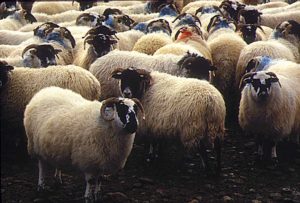Maedi Visna (MV) – On The Increase
21 October 2016 MV has a long incubation period and it can spread unnoticed within, and between, flocks for many years before the non-specific signs are seen. By this time it is likely that at least half of the flock is infected. Culling levels are high with the associated requirement for increased replacement numbers.
MV has a long incubation period and it can spread unnoticed within, and between, flocks for many years before the non-specific signs are seen. By this time it is likely that at least half of the flock is infected. Culling levels are high with the associated requirement for increased replacement numbers.
The main effect is loss of condition, and lambing percentages are often lower in infected flocks. MV can affect the udder resulting in reduced milk production and thinner ewes will have lower milk yields. A high level of bacterial mastitis is another common finding and is possibly due to hungry lambs chewing on the teats and the skin cuts act as a focus for bacteria. Lambs have lower growth rates due to reduced milk supply. Ewes infected with MV are more susceptible to Pasteurella pneumonia so ewe deaths are higher in infected flocks. MV can also affect the spinal cord and ewes may drag a hind leg or be paralysed.
A large scale screening was undertaken in 2012/3 by SAC and the Animal Health and Veterinary Laboratories Agency (AHVLA, now APHA) for Eblex (now AHDB Beef and Lamb) and HCC (Hybu Cig Cymru) to find out the incidence of MV infection in the national flock.
The survey found that in the 15 year period since the previous survey:
- The number of flocks with MV has doubled (from 1.4% to 2.8%)
- The number of infected sheep has increased almost four fold (2 per 1,000 to 8 per 1,000)
- Within the positive flocks the average proportion of infected sheep has almost doubled (13% to 24%)
Although the figures appear low they are increasing. The disease has no cure and there is no vaccine. The disease is at a low level in the pedigree sheep population in Great Britain due to the success of the MV accreditation scheme.
In the commercial sector, and on a nationwide basis, there are more frequent reports of flocks suffering from significant economic effects as the viral disease reaches critical levels and this poses a threat to all sheep flocks.
In 2012 SAC Consulting Veterinary Services started offering a MV diagnostic test package through vet practices who suspected MV may be an issue in their commercial clients’ flocks. The test involves blood sampling some of the thinner ewes in the flock. Around 20% of the tested flocks have shown evidence of MV with, in some instances, most of the sheep in the flock testing positive. In these situations the only solution may be to cull out and restock.
Ian Pritchard
Sign up to the FAS newsletter
Receive updates on news, events and publications from Scotland’s Farm Advisory Service
